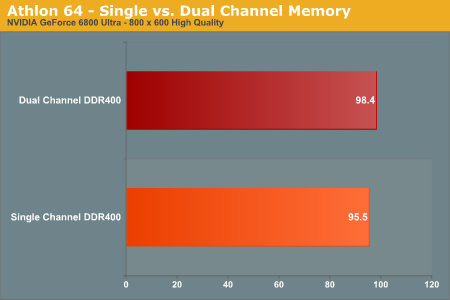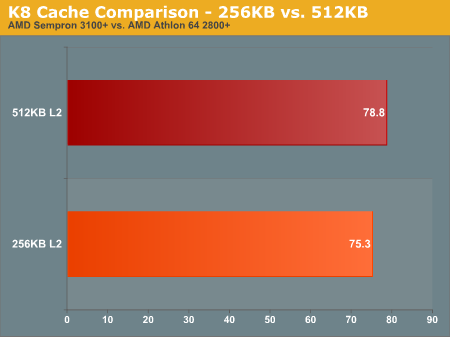Battle 2: AMD vs. AMD
Next up on the fight list for today is AMD, competing against themselves. AMD has gained quite a bit of popularity over the past year and needless to say it is because of their extremely strong showing with the Athlon 64. That being said, with three different flavors of Athlon 64s (Socket-754, Socket-939 and FX) and a lot of users still hanging onto their Athlon XPs, AMD's performance breakdown is an important one to look at.
We know by now that Doom 3 is very cache intensive, which in turns means its very memory intensive - bringing us to our first evaluation: Athlon 64 vs. Athlon 64 FX. The Athlon 64 FX once held two advantages over the Athlon 64, a larger 1MB L2 cache and dual channel memory controller. Now with the introduction of Socket-939, the Athlon 64 also has dual channel capabilities but only on newer chips, not the older Socket-754 offerings. As you can guess, there are two comparisons we'd like to make here: Dual Channel vs Single Channel as well as the impact of cache size on performance.
First we'll tackle dual vs single channel memory interfaces; for this test we used a Socket-939 Athlon 64 FX-51 (2.2GHz/1MB L2) as our Dual Channel platform, and a Socket-754 Athlon 64 3400+ (2.2GHz/1MB L2) as our Single Channel platform. You can see that other than the sockets, the two chips are identical, making this the perfect single vs dual channel memory comparison:

Memory bandwidth doesn't seem to be something that the regular Athlon 64 needs much more of, as the move to dual channel DDR400 only offered a 3% increase in performance. At higher resolutions, the performance advantage would become even smaller. We didn't really expect anything different here, as the dual channel memory interface never really helped the Athlon 64 - definitely not as much as it did the Pentium 4.
Next, let's see how cache size influences Athlon 64 performance under Doom 3. For this comparison we have four chips to compare in two separate sets. We use an Athlon 64 2800+ and a Sempron 3100+, both clocked at 1.8GHz but feature a 512KB and a 256KB L2 cache respectively. We also have an Athlon 64 FX-53 and an Athlon 64 3800+, both clocked at 2.4GHz but feature 1MB and 512KB respective cache sizes. While the four numbers are not directly comparable to one another, the two comparisons do give us an idea of improvements due to cache size varying from 256KB up to 1MB on the Athlon 64:

Looking at the Athlon 64 vs Sempron we see that there's barely a 5% performance difference between the two identically clocked chips, indicating that although a 256KB L2 cache isn't big enough for Doom 3 a 512KB L2 cache doesn't help out that much more. The on-die memory controller helps ensure that despite the small cache size, performance remains very competitive with the competition as we will soon see in our fourth battle.

Our 512KB vs. 1MB L2 cache size comparison reveals something interesting: it's not that a 512KB L2 cache isn't big enough for Doom 3 (which is the case with the Pentium 4), it's that the Athlon 64's on-die memory controller effectively masks the need for a large L2 cache in Doom 3. Going to a 1MB L2 cache results in less than a 4% performance improvement, much less than what we saw with Prescott vs. Northwood.
Bottom line: cache size is far less important for the Athlon 64 than on the Pentium 4 as you would expect thanks to the on-die memory controller.










59 Comments
View All Comments
PrinceGaz - Wednesday, August 4, 2004 - link
The amount of System memory (above 512MB) is unlikely to have any impact on framerate in the timedemo as I doubt it would need to swap anything out after the first run (which is discarded anyway).I found my 128MB graphics-card (a Ti4200) gave an almost identical framerate at Low, Medium, and High quality settings in the timedemo even when gfx-card limited, provided Aniso was disabled in the driver for High quality mode (which would otherwise use 8x Aniso and impact on performance in other ways). So increasing the videocard memory from 128MB to 256MB will have no effect whatsoever on the timedemo, except maybe at Ultra quality which I didn't bother testing.
Steve Guilliot - Wednesday, August 4, 2004 - link
#27That's the OS load balancing between the two procs. Two D3 threads aren't running at once. That's why sum utilization of both procs won't go over 100%.
Succorso - Wednesday, August 4, 2004 - link
Is this review using XP or XP64 beta with the amd64 ? Are the benefits the same using a 32bitXP as opposed to the 64 bit XP ?Succorso
SignalPST - Wednesday, August 4, 2004 - link
its interesting how DOOM3 runs best in the Nvidia/AMD combo along with the amazing price/performance that they offer over their competitorsthe Athlon64 3000+ is on par with Intel's 3.4GHz EE, while the price difference is $840
the GeForce 6800 GT is faster than ATI's X800XT PE, the price difference being $160
so in this scenario, the Nvidia+AMD combo can save you $1000 and still outperform the ATI+Intel combo
bottom line, for DOOM3 and future DOOM3 engine games, ATI+Intel=losers
cKGunslinger - Wednesday, August 4, 2004 - link
Yes, I would also like to see some numbers benchmarking 256/364/512/768/1024/etc MB memory configurations. When does the average system have *enough* ram to run WinXP and play a game?xtf - Wednesday, August 4, 2004 - link
Would it be possible to add the cache (and other) specs of the K7s to certain charts?Because sometimes the 2700 and 2800 are slower than then the 2500 and it'd be interesting to know why.
tdent1138 - Wednesday, August 4, 2004 - link
Great article AT! I'm happy to know my 2.53Ghz @ 2.717Ghz P4 and 9800pro will happily run D3 at 8x6 in medium quality. I can now wait until HL2 at least to upgrade to whatever makes sense at the time (A64 something I imagine). Thanks again!tdent1138 - Wednesday, August 4, 2004 - link
Philbill - Wednesday, August 4, 2004 - link
Great article, Do you plan to give an update with the high end ATI cards?Phil
dangereuxjeux - Wednesday, August 4, 2004 - link
Somehow, I feel ashamed that the Sempron 3100+ crushes my ol' P4 2.4C.... please please please stop publishing articles like this that encourage me to spend any more of my money upgrading to a new AMD platform to go along with my 6800.